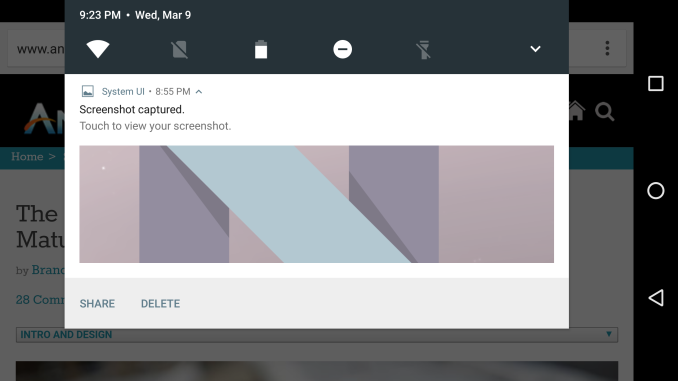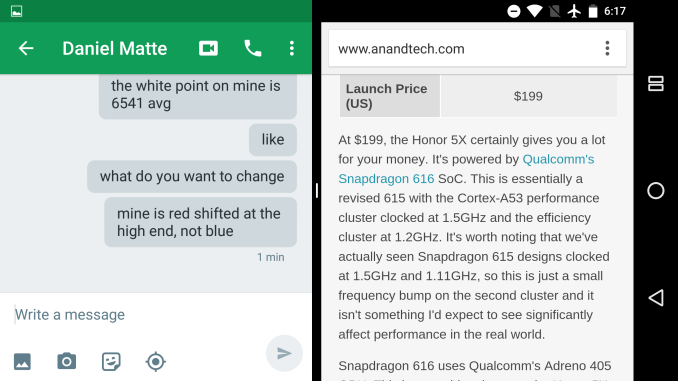Hands-On With the Android N Developer Beta: Multi-Window & More
by Brandon Chester on March 10, 2016 8:00 AM EST- Posted in
- Smartphones
- Android
- Mobile
- Tablets
Initial Impressions
Though I suspect it's not a popular opinion, I have long felt that the software design ecosystem for Android tablets has been stuck in a rut since the early days, and as a result users have struggled to find good, modern applications that really excel at the tablet experience. Android N can't magically bring proper tablet interfaces to all Android apps, but the Multi-Window support is a big help in improving the situation. With split windows in use, on a standard tablet you're really dealing with a screen segmented into two areas, and this is where a phone layout works pretty well. With that in mind, it does help to address the problems that Android tablets currently face, but I do hope that developers will continue to maintain existing tablet UIs, and that new developers will take the time to create ones. I don't know if Google's internal app development groups are prepared for this, but I have faith in the larger Android's developer community.
It's worth noting that the Multi-Window mode technically also works on phones. That said, unless you have a 6.8" phone (which is practically a tablet), I don't think the feature is very useful, but it's there. Even on the Nexus 6 there's just not enough screen space, and I would never use it myself. That said, while I was initially ttempted to recommend that Google just remove the feature on phones, on reflection it doesn't really hurt anyone to have it there for users that want it. On top of that, leaving it to tablets alone may cause some developers to just not support the feature entirely.
Google also has an advantage with Android apps already being designed to support many resolutions and aspect ratios. Several apps that I tried already worked with the split screen mode, and developers aren't going to have to rebuild their UIs like they did when Apple introduced split screen multitasking on iOS. In fact, it's most certainly the case that there are more apps that work with Android N's multitasking than there are that work with multitasking on the iPad, and considering that the feature just launched today in a beta OS I'd say that's a big win for Google and for Android.
If I were to make any recommendations for Google, it would be to make it a bit more obvious to the user that you can hold down the multitasking button inside an app to instantly get into split view mode. I happened to come across it because I figured that Google would have implemented some sort of quick access method, but it's not obvious enough for your average user. In addition, I think the current method of simply filling the view with the background color as you adjust the ratio between apps is not very aesthetically pleasing. These apps still aren't really designed to adjust their UI in real time, and although it's somewhat lame to just blur it out like Apple does on iOS, it looks better than watching the UI frantically try to fill the space.

Quick toggles are easier to access in Android N
As for Google's other changes, I think they're in line with what we've come to expect. After Lollipop, Google was able to step back and focus on the lower level problems with their platform, particularly regarding efficiency. The improvements to Doze will certainly have an impact on energy usage, and blocking apps from waking up in large numbers whenever the phone goes on or off of WiFi is a smart move. I expect that we'll see continued improvement of this sort in future Android releases, as problems with energy management are potentially the biggest problem plaguing the platform right now, with performance and usability having been mostly sorted out. These releases also provide a way for Google to make small improvements to areas like notifications and their built in applications to make the user experience a lot better through many little changes.
On that note, I'm sure many of our more technical readers are interested in being part of the beta. I'm very happy that Google has taken the necessary steps to make the process of enrolling in the program much easier for developers and users. Right now the supported devices include the Pixel C, Nexus 9, Nexus 5X, Nexus 6, Nexus 6P, and Nexus Player. To enroll your device in the beta you can visit this link and your device will quickly notify you that an update is available. It does need to be reiterated that this is a developer beta and a true beta at that - it's not a large-stage end-user beta - but I would encourage enthusiasts who do enroll to consider sending some feedback to Google about what they like and what could be improved, as that's ultimately what these beta programs are all about.
One last thing to note is Google's incentive for developers to test their apps on tablets so they can ensure proper Multi-Window support. For a limited time developers can sign up here to get a promo code which will knock 25% off the cost of the Google Pixel C. With Google recently having patched the most serious bugs on the Pixel C, for $375 it's a pretty good tablet and a very good device for doing application testing considering the fact that the Android N beta only works on two tablets. Interested developers can sign up here, and Google is seemingly taking people on faith that they really do intend to use the unit for development as it only involves entering your email address.
With Android N being in its early stages, I must say that I'm impressed with the stability and usability of the features that Google has added. With Google IO on the horizon we'll certainly be hearing more about what's coming in Android N, and I'm very excited about the direction Google is headed in.












124 Comments
View All Comments
BurntMyBacon - Monday, March 14, 2016 - link
@UtilityMax: "I have never seen something like a Surface Pro x being used in a pure tablet mode."I have. Works just fine. Not something I'd call superior to the competition, but better than many give it credit for. It's as ET said above, for most people it is only worth it as a 2-in-1 device. For a tablet only experience, it isn't compelling enough to pull people from competitors.
BurntMyBacon - Monday, March 14, 2016 - link
@ET: "A Windows tablet (IMO) is only worth it as a 2-in-1, ..."I don't disagree. If you are getting a windows tablet that isn't 2-in-1 in some fashion, then you are missing out on the primary advantage of windows tablets.
@ET: "..., and even then I think that most people who spent significant time using tablet mode will get a better experience with a Windows ultrabook plus an Android tablet."
It really depends on if you have the luxury of bringing two devices with you and what you are doing in tablet mode. If seamless integration is beneficial, then two devices may not be the best bet. That said, I have to agree, most people don't fall into these caveats and would probably be better served by separate devices.
BurntMyBacon - Monday, March 14, 2016 - link
@ET: "I'd much rather use my Galaxy Tab S 8.4 than any Windows tablet. Android offers a better "desktop" ..."Wow. My Nexus 7 (2013) doesn't provide anywhere near the the quality desktop of a windows device (tablet or otherwise). Is this a Samsung specific improvement. I've heard so many terrible things about TouchWiz from so many people, but if it can really provide a superior desktop, then I need to check it out. Or is it that you have third party software that makes the difference.
shadarlo - Thursday, March 10, 2016 - link
This x1000Why anyone would buy an iOS or Android tablet for anything more than $200 is beyond me. For anything above that you can find a windows tablet that is so much more useful. And even more ridiculous is $500-$1000 for a non windows tablet.
raptormissle - Thursday, March 10, 2016 - link
Fortunately, the majority disagree with you. Anyone who buys a Windows tablet over an iOS or Android tablet is just looking to run their old clunky windows apps on a tablet. The OS and apps are no where near optimized for tablet use and you really need to be a hardcore windows fan to even tolerate it, No wonder windows tablet sales continue to suck.Ratman6161 - Thursday, March 10, 2016 - link
"Anyone who buys a Windows tablet over an iOS or Android tablet is just looking to run their old clunky windows apps on a tablet. "Or....simply has a different use case than you do. Everyone thinks that whatever they have is the best. And it probably is...for them. Not necessarily for eveyone
ET - Thursday, March 10, 2016 - link
That argument goes both ways. I'd say that for most tablet use cases Windows is inferior.UtilityMax - Saturday, March 12, 2016 - link
For one, a larger screen makes it worth to pay more for an android tablet. It is indeed true you can find very good 8 inch tablets for 200-250 these days, but if you want 10 inch screen, then the price is 300-500. I use my tablet as a protable TV/video screen I can take everywhere, and Android works well enough for that. Windows tables are much bigger and heavier, and basically feel more like netbook or notebook without a keyboard attached.darkich - Thursday, March 10, 2016 - link
.. Wait, did you just said that Android apps run better via bluestack on a windows device, than they do on actual Android devices?!?lexluthermiester - Thursday, March 10, 2016 - link
Speak for yourself. I love my Android tablets! iOS and Windows are craptastic on tablets in my opinion. Windows 10 is only useful in standard desktop mode, but with it's privacy and security problems, it's just not worth it. Then again, Android 5.x is ugly as and a backtrack from KitKat. 6.x fixes a few of those issues but it's still very unappealing to the eye.